The Secret Science of Sway: How Danish Mobiles Nail the “Equilibrium of Moments”
I’m Ken Kuwako, a Science Trainer. Every day is an experiment!
The colorful decorations that sway gently—mobiles. They are so soothing just to look at, aren’t they? But have you ever stopped to wonder, “How is that exquisite balance achieved?” Believe it or not, there’s a fascinating physics “secret” hidden inside that simple form.
Today, let’s uncover that secret, along with my personal story of becoming obsessed with mobiles as an elementary school student and finally getting my hands on a beautiful Danish one as an adult!
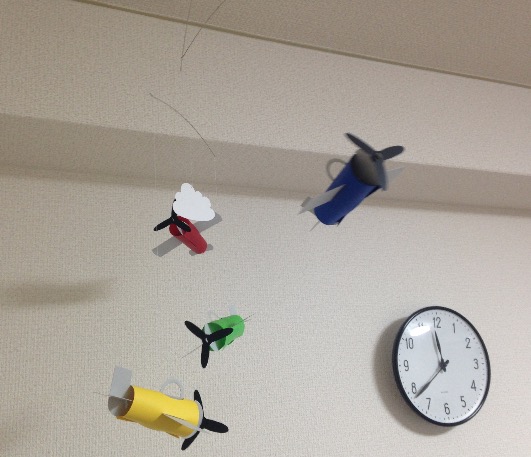
The Principle of the Lever Hidden in Mobiles
When I was in elementary school, I loved mobiles so much that I started making my own. I made several, but I could never create one that I was truly satisfied with. The fun of a mobile lies in how it maintains an exquisite equilibrium in a spot where you’d think balance is impossible. You never get tired of watching them sway gently in the breeze.
The truth is, this is exactly the same as the principle of the lever you learn about in science class. With the fulcrum (the point where the thread hangs) at the center, the “weight” on the left and right, and the “distance from the fulcrum,” are perfectly balanced. The reason I struggled so much as a kid was precisely because finding this “balance” was so tricky.
I got another chance to make one during an art class in junior high, and that’s when I finally managed to create a mobile I was happy with.
A Gift from Denmark, the Birthplace of Mobiles
I had mostly forgotten about my mobile obsession, but recently I bought a plastic-paper mobile made in Denmark, which is considered the birthplace of the mobile.

Here it is. It’s a mobile by FLENSTED (Flensted Mobiles). They also have various other designs, like hot air balloons and whales!


The one I purchased has an airplane design.

Isn’t it beautiful? You don’t often see such vibrant, primary-colored mobiles made in Japan. It really showcases the unique color sense of Scandinavian design.
Time to Assemble!
I immediately started putting it together. Opening the box…
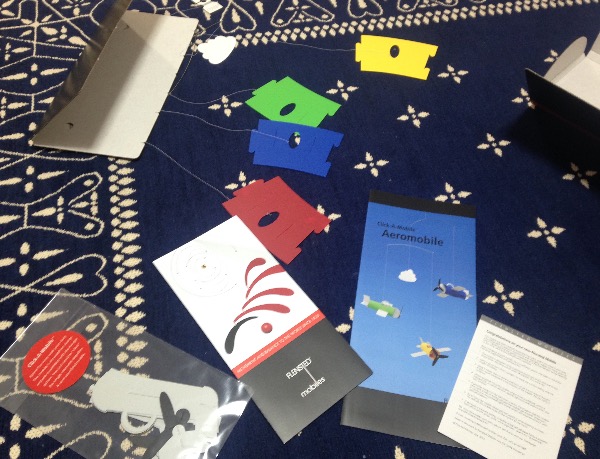
The strings and balance sections were already assembled; all I had to do was attach the airplanes to the parts. However, this part was surprisingly tricky, and it took me a good 30 minutes to attach all four airplanes. It’s detailed work! If you’re building this with your children, make sure to lend a helping hand! (^^)
Finished! The Airplane Mobile and the “Equilibrium of Moments”
Here it is!
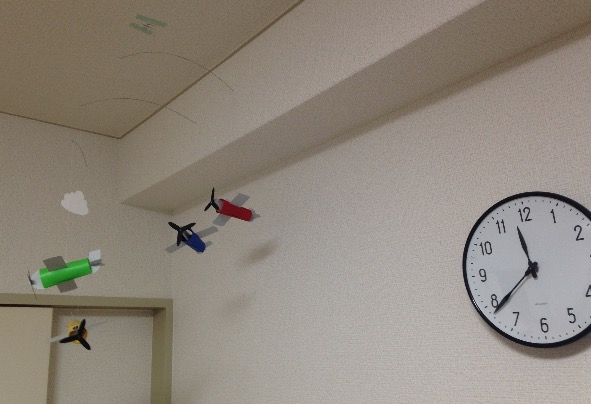
Isn’t it gorgeous? I hung it right above my computer. Watching it sway is truly soothing.
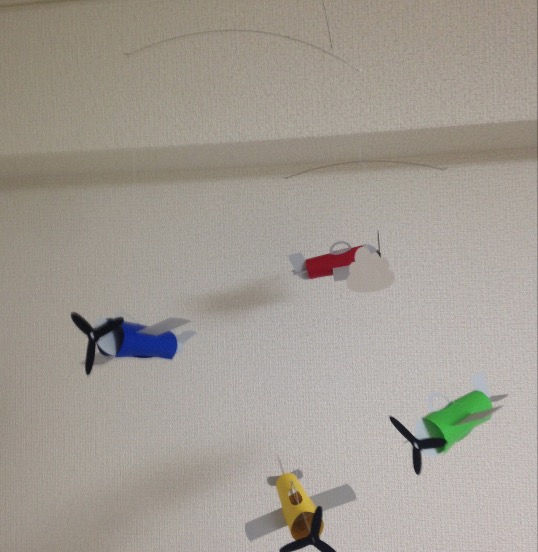
Now, this is where the science teacher comes in! The great thing about this mobile is that the weight of every airplane is identical. So why does it balance so perfectly? The secret lies in what we call the “Equilibrium of Moments” in physics. That sounds complicated, but just think of a seesaw. When two people of different weights get on, they balance if the heavier person sits closer to the fulcrum (the center) and the lighter person sits further away, right?
A moment is the “force that causes an object to rotate,” determined by the formula: Distance (from the fulcrum) × Weight. In this mobile, the moments on the left and right sides of the fulcrum (the hanging point) are equal at every level.
Let’s look at the very bottom section. The yellow and green airplanes are suspended. Both have the same weight, and they are suspended from the exact middle. This means both the “distance” and “weight” are the same, resulting in a perfect balance.
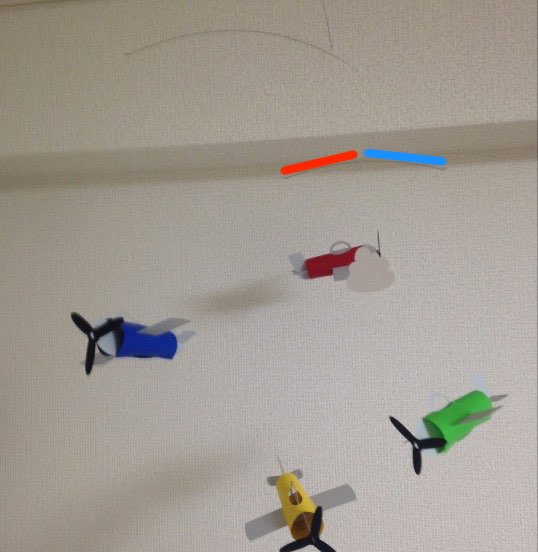
Above that, we have one blue airplane and the combined “Yellow + Green airplanes (a total of 2 units).” This time, the weights are different: “1 unit” versus “2 units.” Therefore, the fulcrum is not in the middle. The heavier “2-unit” side is closer to the fulcrum, and the lighter “1-unit” side is further away.
If you look closely, can you see that the ratio of the distances from the fulcrum is the inverse of the weight ratio, or “2:1”? This is precisely the Equilibrium of Moments!
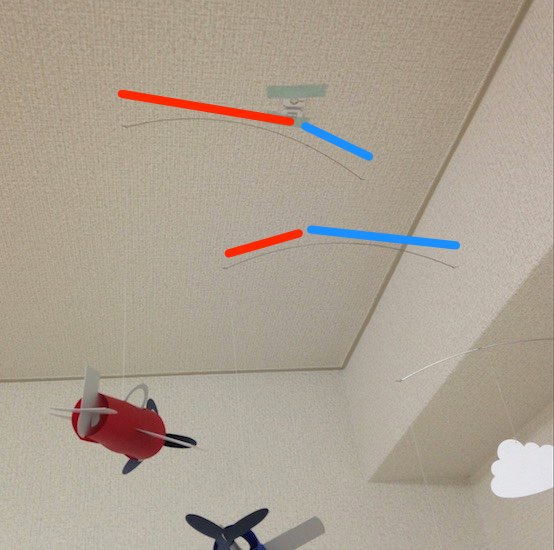
Going up one more level, we have the red airplane (1 unit) and the three planes below it (Blue + Yellow + Green = 3 units) suspended. So, the ratio of the distances from the fulcrum is… you guessed it! It’s the inverse of the weight ratio, “3:1”! This shows how the “Equilibrium of Moments” is perfectly calculated at every single level, all the way up to the very top string. What a lesson in science! This is a masterpiece I’d love to display in my science classroom!
The Physics Hidden in the Sway
What did you think? The Danish mobile is not only beautiful but also packed with the laws of physics.
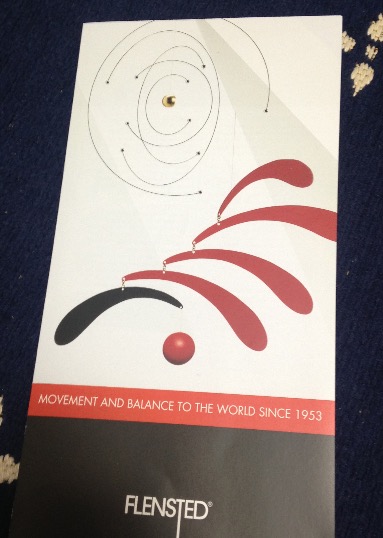
Mobiles, which change shape gently when touched by the wind, are often called “moving sculptures.” Doesn’t it make you feel a little excited to know that this much science is hidden within their gentle swaying?
Contact and Requests
Bring the wonder and fun of science closer to you! I’ve put together easy-to-understand tips and fun science experiments you can do at home. Feel free to search around!
The content of Science Notebook is now available as a book. Click here for details.
For information on the author, Ken Kuwako, click here.
For various requests (writing, lectures, science classes, TV supervision, appearances, etc.), click here. – Updates on articles are available on X!
![]() We are also sharing experiment videos on the Kagaku no Neta Channel!
We are also sharing experiment videos on the Kagaku no Neta Channel!


